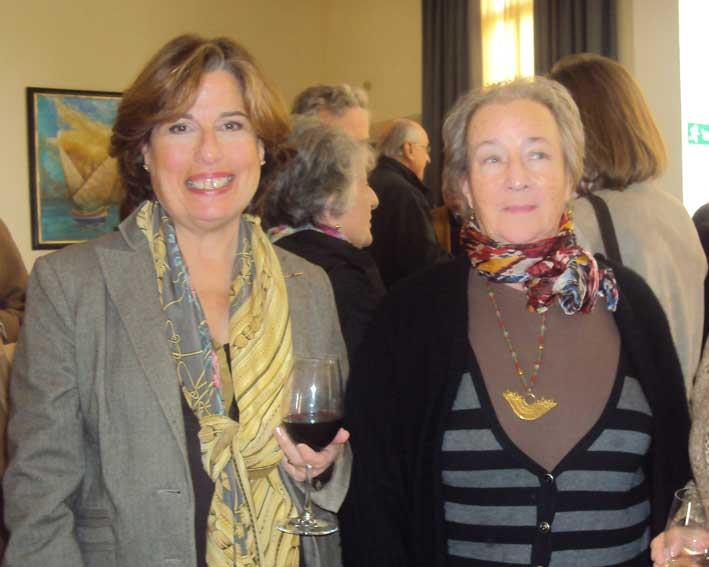I distinctly recall going to Peter Apap Bologna's 18th birthday party at his beautiful family home in Lija. I wore a red dress. I was a wall flower for most of the evening and really wanted to hide behind the red damask curtains for most of the time as I was painfully shy and blushed every time some young man approached me. Years later I enjoyed collaborating with Peter and his wife Alaine when they opened the Melitensia Art Gallery in Transfiguration Avenue, Lija. It was certainly an exciting time mostly due to the fact that they are both so knowledgeable and love people. There was always someone interesting to meet at The Melitensia Art Gallery - either over a glass of wine and more often than not, over a pleasant lunch, Peter and Alaine both being excellent cooks.
They moved to Sliema some years ago and have been very generous with their time, sharing their knowledge, organizing art exhibitions and helping in so many ways St Patrick's. As a matter of fact Memories is published at the Salesian Press.

I was one of those few lucky enough to receive a draft copy of the book. I was fascinated and read it in two days. I simply could not put it down. Peter managed to capture the Zeigeist of those years admirably. Memories is so well illustrated with photographs and cuttings. The author is clearly a meticulous organizer and has kept letters, photographs, cuttings over all these years. And he must have kept a diary or at least notes to be able to come up with so many details.

The launch of the book took place last month at St Patrick's on a Saturday morning. Considering there was the Archbishop's installation, as well as a bridged weekend to contend with quite a number of people turned up and enjoyed the event, now all considerably older than the photos in Memories. A handful from my long lost girlhood were there, among them my school friend Rita Gatt, who married Cons Mizzi and who never ceases to amaze me with her strong faith inspite of the fact that she lost a daughter.
Two of the three Flannery sisters Deborah and Lucinda were there. Esmé, who was in my class at the Convent of the Sacred Heart, was abroad with her husband so unable to come. They were a family of five children and lived in Villa Lia and were neighbours of the Apap Bolognas. They became close friends, a friendship that has lasted until now. Peter writes about them with affection. Their father was a naval surgeon and their mother American and a staunch Catholic. All the girls now live in Malta. Lucinda married Salv. Stellini, one of the few heartthrobs of my generation.
* * *
Lawrence Grech, my very first editor, was there. Lawrence is a man of great culture and an intellectual all rounder and a most pleasant man. Peter mentions him, Lorie Scicluna, Martin's wife and his own daughter Sarah Apap Bologna for it is to them that he is indebted for 'meticulous editing and proofreading.'
I remember, all those years ago, taking an interview with Anthony Burgess to Lawrence Grech, in the old Times building in St Paul's Street. It was a scoop even if I did not know it. Anthony Burgess and his wife and son lived in Lija and one day he sent a message that he wanted to meet me. I belonged to The Censorship Reform Group and regularly wrote in The Sunday Times and The Times about the absurdity of the local censors. The Burgesses invited me to their home regularly. Anthony was a good cook and his Italian wife, Liana, often complained that the local garlic was far too small. In the interview Anthony, whose books, as well as those of Desmond Morris were sometimes censored at the post office, said that it was not for Archbishop Gonzi to concern himself with people's bedrooms. Lawrence said he would have to censor that bit. I argued that no, the interview either had to be published in full, with no blue penciling or I was going to withdraw it. Lawrence gave in and I eventually received the going rate of two Malta pounds. There were no word processors then. Goodness knows how many times I had typed it and retyped it on my little red Olivetti but I was happy to eventually receive the fee, add a few pounds to it and buy myself a bottle of Diorissimo or Calèche.
Martin Scicluna whose mother and Mrs Amy Apap Bologna were very close friends, as he wrote in his excellent review in The Times some weeks ago, was there. Martin also wrote the blurb for the book and said that Memories could establish Peter 'as the Chips Channon of Malta - a social and political diarist of an era of Maltese history long gone, but whose nostalgic memories linger on.' I loved his excellent review and his commentary in the blurb of the book.
I have almost finished the published version of Memories and will write my impressions of it in the coming weeks. Although publishers and booksellers are having a hard time selling books however, it seems that memoirs are selling well. Peter's Memories deserves to be read especially by those of his generation who understand his world. Once you start reading it you, like me, will be unable to put the volume down.
There are promises of two more volumes to follow, brave man that he is.